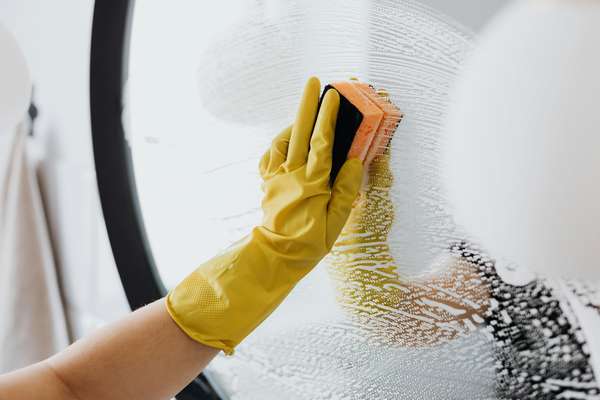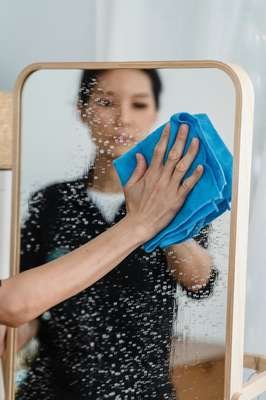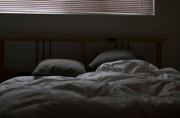
There's nothing quite as maddening as spending ages cleaning a mirror, only to step back and see it covered in streaks and smudges. You tilt your head, squint, and maybe even grab the cloth again, but somehow, it just won’t come clean.
Sound familiar? You’re not alone. Plenty of us have wiped, re-wiped, and then finally given up on that stubborn bathroom mirror, wondering what we’re doing wrong.
Here’s the good news: there’s usually a simple reason those streaks keep coming back—and an even simpler way to stop them for good.
Professional cleaners have cracked the code, and it turns out the secret lies in two humble pantry ingredients you probably already own.
The foolproof vinegar method
The best mirror cleaning solution is a homemade vinegar-and-water mixture, which doesn't contain soap like many premixed formulas that can lead to streaky mirrors. Here's how to do it properly:
What you'll need:
Equal parts distilled white vinegar and water
Microfiber cloth
Spray bottle
The technique:
Mix equal parts vinegar and water in a spray bottle. If your tap water often has mineral deposits (which leads to those water stains around your faucet), then opt for distilled water.
Spray the mixture directly onto a microfiber cloth rather than the mirror itself, then wipe in a zigzag pattern down the entire length of the glass.
Dry the mirror with a fresh microfiber cloth using similar motions.
Why microfiber works so well
The small fibers in a microfiber cloth are designed to absorb or cling to anything they come into contact with.
This means they will absorb the cleaning liquid you use, and also grab onto any dirt or grime from your glass.
Thin flat-weave microfiber cloths are even less prone to leaving behind streaks or lint on glass.
The baking soda paste for stubborn stains
When you're dealing with hard water marks—those chalky white marks that seem impossible to budge—baking soda is your secret weapon. Here's how:
What you'll need:
Baking soda
Distilled water
Cloth
The technique:
Create a paste using equal parts baking soda and water, until it reaches toothpaste consistency.
Apply this directly to the stained areas, let it sit until dry, then wipe clean with a damp cloth.
Baking soda works wonderfully on most surfaces, and if needed, you can spray a little vinegar on it and watch it fizz for extra cleaning power.
Don't make these streak-causing mistakes
Most mirror disasters happen because of these common blunders that even experienced cleaners make:

The circular motion trap
Never wipe in a circular motion, which generates static that attracts dust.
Circular motions during cleaning can result in streaks.
Instead, adopt a vertical or horizontal wiping motion to ensure an even application of cleaning solution and a streak-free finish.
Using too much cleaning solution
Don't use too much cleaning product when cleaning your mirror.
A large amount of cleaning product can cause streaking and staining.
It's tempting to douse your mirror in a cleaning solution, but excess cleaner can leave behind a residue that causes streaks.
Skipping the dust step
Dust and debris on the mirror's surface can turn into streaks when mixed with cleaning solution.
Always dust your mirror before spraying it with a cleaner.
Wrong cloth choices
Paper towels and newspapers can technically be used for cleaning mirrors, but they're poor choices.
Paper products leave unsightly streaks, lint, dust, and newsprint residue on glass surfaces.
Paper towels and tissues may seem soft, but they have a raw, unrefined surface that attracts dust, creating a rough, abrasive surface that can encourage small scratches on your glass.
Senior-friendly mirror cleaning tips
If you're dealing with arthritis or joint issues, mirror cleaning doesn't have to be a painful chore.
Here are some adaptations that can make the job much easier:
Tool modifications
You can find cleaning tools with comfortable, large rubber handles and grips. The bigger the grip, the better.
Microfiber cloths and gloves can also be worn instead of gripped.
Pacing strategies
Pace yourself—if you carefully plan and organize your activities, you can make the most of your energy.
Pacing helps you to do what you want to do without increasing your pain or fatigue.
Set a steady pace and take a break before you get tired and sore.
Schedule the most difficult tasks for the time of day you feel your best.
If mornings are challenging, consider saving more physically demanding tasks—like cleaning the bathroom—for later in the day, once you've had time to get moving and your muscles have warmed up.
Smart positioning
Cleaning mirrors directly after a shower is really effective.
You can clean them with a microfiber cloth attachment while the surface is still slightly warm.
This timing also means you're already in the bathroom, reducing unnecessary trips.
How often should you clean your mirrors?
The frequency depends on location and use:
Bathroom mirrors: Should be cleaned at least once per week due to steam, toothpaste splatters, and daily use.
Bedroom and hallway mirrors: Decorative mirrors can be cleaned every three to five weeks as they accumulate less grime
What's your biggest mirror cleaning frustration—streaks, water spots, or something else entirely? Share your experiences and any tricks you've discovered in the comments below. We'd love to hear what works (or doesn't work) for you!






